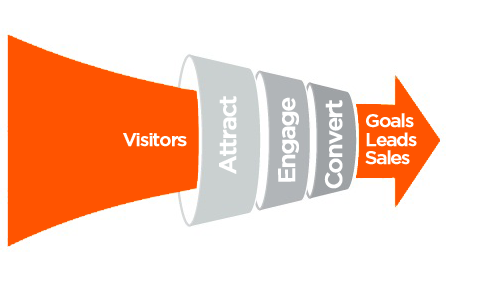As an ecommerce entrepreneur, what are the most important things for you to focus on? Symon Edmonds from MonkeyData gives you the low-down on the most significant metrics to watch in your online store and strategies to optimize them.
Conversion rate
Simply put, your website’s conversion rate is the percentage of visitors who take a desired action. Primarily, the conversion rate focuses on purchases, but can also be calculated for other desired actions such as ebook downloads, newsletter sign-ups and lead form completions.
For example, if 1,000 visitors came to your website and 25 made a purchase (or performed some other desired action), your conversion rate would be 2.5%.You can easily look at this in your online store by setting up goals in Google Analytics. This way, you can track in Google Analytics how many visitors perform a given desired action.
You can also easily look at conversion rates across campaigns, so that you can compare and optimize different campaigns.Your conversion rate will be the product of many different functions in your website.
You need to create a great website that is visually appealing as well as functional and easy to navigate, have a great product with excellent pictures and descriptions, and have all the other logistical nuts and bolts figured out for your website.
Some other important considerations for increasing your website’s conversion rate include:
-making a good impression with your home page and landing pages.
-developing a reputable brand that people want to buy from (you can do this by establishing credibility in your niche with great content).
-keeping your product categories simple.
-making your products unique/offering a unique value proposition to your customers that other businesses cannot match.
-having clear product return policies.
-having appropriate payment methods available (this will vary depending on which markets you are operating in).
Optimizing your conversion rate involves a fair amount of testing. You will have to test different campaigns, landing pages and versions of your website to see what works best in terms of conversion. A great tool for this is Optimizely. This tool allows you to test different versions of your website and send a certain percentage of visitors to each version of your website (cookies ensure that the user sees the same version of the website each time they visit).
Customer acquisition cost
Your customer acquisition cost (CAC) is the average amount that it costs to acquire a new customer. This is calculated by taking all of your marketing costs over a certain period and dividing it by the number of customers acquired for that period. This is important to monitor as it will help to measure the profitability of your business and specific campaigns. Also, it is directly tied to your conversion rate.
For example, if you spent $1,000 on a particular marketing campaign and it brought you 20 customers, your customer acquisition cost for that campaign would be $50 ($1,000 divided by 20).
This is important to know, because it will help you determine if the campaign is profitable or not. If, in this example, you make a gross margin (revenue minus product cost) of $100 per customer, this campaign would be profitable. However, if you only had a gross margin of $25 per customer, this campaign would be unprofitable.
However, this process becomes more complicated if customers come into contact with multiple campaigns. For instance, a customer might first visit your website by clicking on a Facebook ad, but then may again click on your website through an Adwords ad. Which campaign should get credit for the conversion? How do you allocate conversion values to each campaign? Fortunately, there is a way to do this in Google Analytics. Here, there are a variety of attribution models that you can apply to your marketing campaigns. Are the first or last clicks most important? Do you value each click equally?
Let’s look at a hypothetical example. Let’s say the conversion value for a particular customer is $100 and they clicked on ads from four different campaigns before making a purchase on your website. Using first click attribution, the first ad that the customer clicked on would register a conversion value of $100, while all others would have a conversion value of $0. If you used a linear attribution model, each campaign would be considered equally important to the conversion and receive a conversion value of $25.
In this example, let’s also say that your marketing cost was $5 in each channel. Under the first click attribution model, the first campaign would have a profit of $95 ($100-$5) while the other three would have a profit of -$5. In a linear attribution model, each campaign would have a profit of $20 ($25-$5).

The attribution model that you choose depends on how your business operates and how you believe your customers convert. For more details on the different types of attribution models, check out this post here.
There are several ways that you can reduce your customer acquisition cost. One way is to embed virality into your product. Use a referral program from a site such as Referral Candy to reward your customers for referring a friend to your products. This is a very cost-effective way to acquire new customers and will reduce your overall customer acquisition cost.
Another way to reduce your customer acquisition focus is to get granular with your data and focus only on your most profitable campaigns. See what segments have the lowest customer acquisition cost and direct your marketing dollars towards them. Cut the campaigns which aren’t working and get rid of the waste.
Remarketing campaigns are a great way to reduce your customer acquisition cost as people who have already visited your website are more likely to come back and make a purchase than those who are visiting for the first time.Finally, leverage your organic marketing efforts to bring more free traffic to your website.
Team up with merchants offering similar products and services and cross-market to each other’s customers. Engage your customers with relevant email offers and content that will entice them to buy your products. Provide great customer support to guide people through the purchase process.
Finally, always keep innovating and providing value to your customers, so that they will be more likely to purchase, which will increase your conversion rate and thereby reduce your customer acquisition costs.
Customer lifetime value

The customer lifetime value (LTV) is how much a customer spends in your online store throughout their entire lifetime. Customer lifetime value is a function of the average number of purchases a customer makes in your online store and their average order value. Having strong customer retention programs is a great way to maximize customer lifetime value. It is also important to compare this metric directly to your customer acquisition cost. This will tell you if your business is profitable or not.
We suggest having LTV:CAC ratio of 3, meaning that you make $3 for every $1 you spend acquiring your customers. This gives you plenty of room to be profitable. If your LTV:CAC ratio is greater than 3, it likely means that you can be more aggressive with your marketing dollars.
LTV can be calculated with a simple formula. Take the average order value of your customers and multiply that by the average number of purchases made in their lifetime. It may also be interesting for you to look at this metric for customers over a different period of time (say 3 years) to get an idea of what their LTV will be. This is because newer customers will have not had the chance to realize their full LTV yet, and it may make more sense to calculate this metric with customers who have been with you for more than 3 years (or whatever amount of time makes the most sense for your business).
There are many strategies that you can take to increase your LTV. As we mentioned, LTV is a function of average order value and the number of purchases made, but merchants also need to take into consideration customer retention.
Targeting your customers with retention offers is a great way to get them coming back to your store and to increase your LTV. Offer relevant, seasonal and valuable offers for your customers, and they will surely come back for more. Ostensibly, using strategies to increase your AOV will also increase your LTV.
Another important strategy to consider is creating a subscription service for your products. This is where you send your customers a box of goods every month on a subscription payment model. This is especially useful if your products are consumable, and people need to stock up periodically. A company that does a great job of this is Birchbox. They send personalized samples of beauty products to their customers every month for a subscription fee.
Essentially, by doing all of the other things right in your online store, your customer lifetime value will benefit. However, this is a very important metric to track, as it is the best barometer to measure how your segments are performing relative to their respective marketing costs.
This is end of part 1 of this article. Here you can read: PART 2

